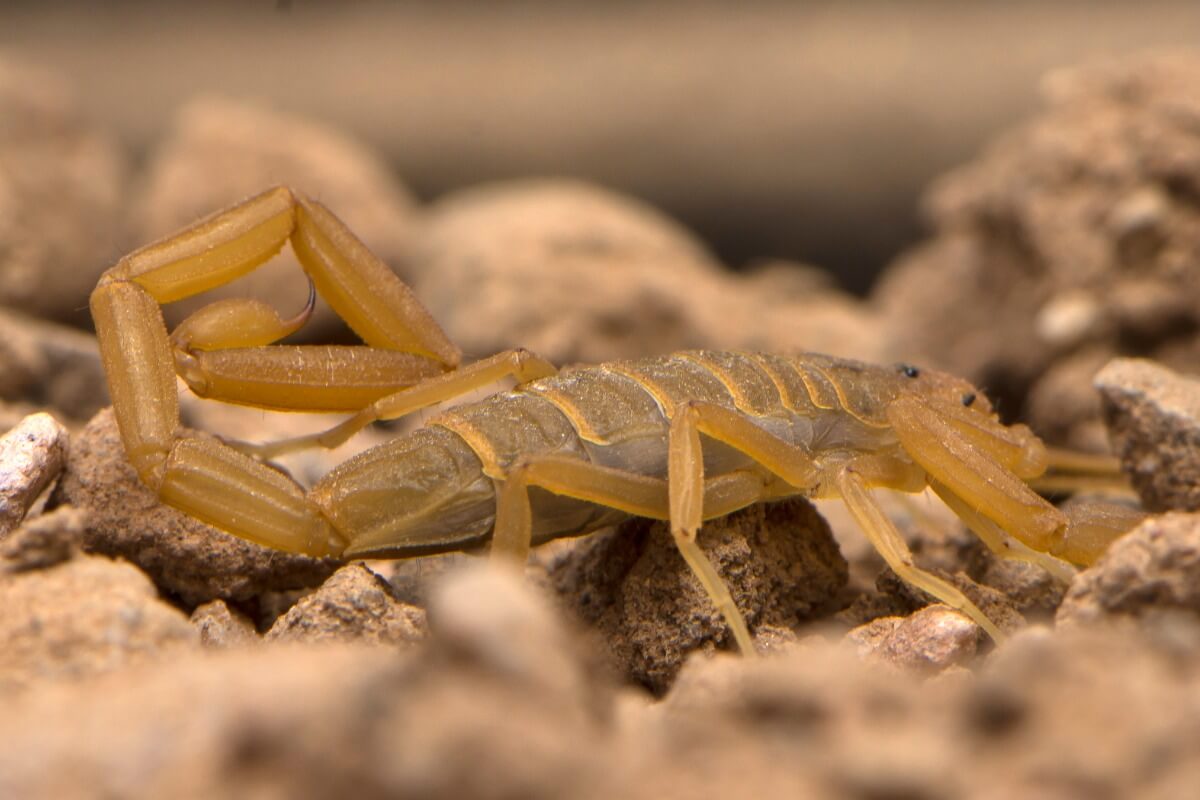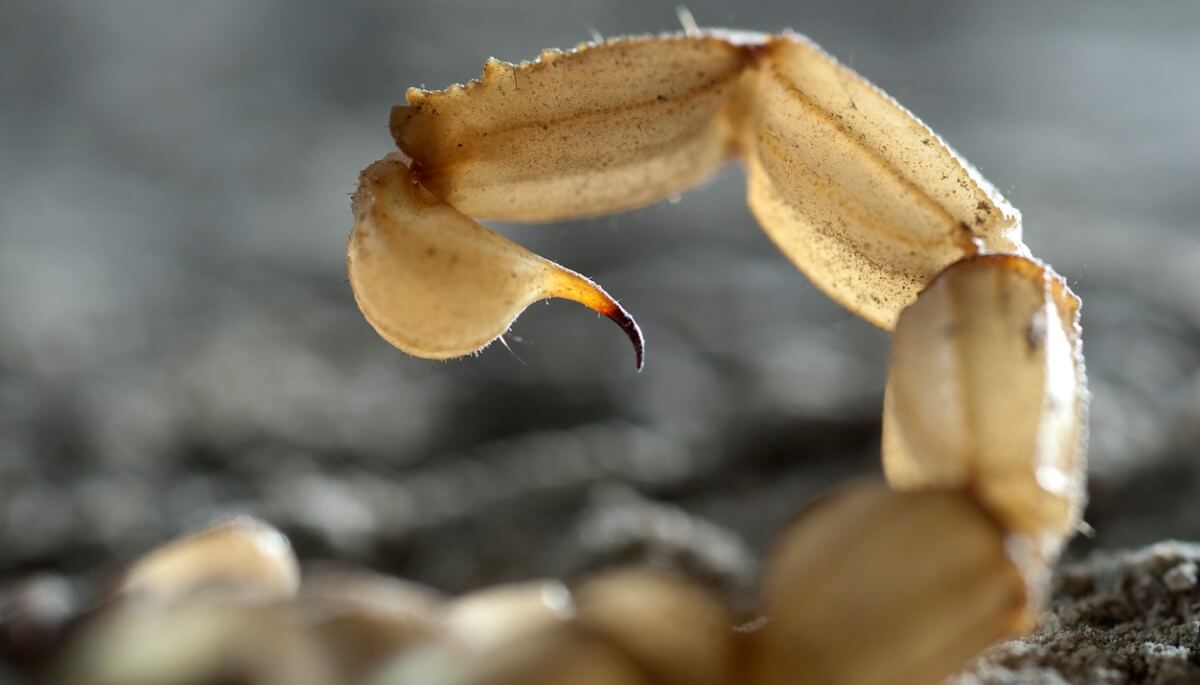The Arizona Bark Scorpion: Everything You Need to Know


Written and verified by the biologist Francisco Morata Carramolino
The Arizona bark scorpion, scientifically named Centruroides sculpturatus, is one of the scorpion species that can be found in Mexico and the United States. It belongs to the Buthidae group, the largest family of scorpions that exists, with more than 90 genera and 1000 species registered so far.
Despite its small size, the Arizona bark scorpion is the most poisonous scorpion in North America. Its bite is capable of causing severe symptoms in humans, which very occasionally even lead to death.
As a consequence, this is also one of the best-known species by the general population, at least in the areas where it’s endemic. We invite you to continue reading if you want to learn more about the biology of this animal.
Characteristics of the Arizona bark scorpion
This scorpion is very representative in its family. Its size is medium to small, it’s close to 8 centimeters in males and 7 centimeters in females. The limbs and the metasoma (tail) are mustard yellow, while the segments that make up the mesosome (body) have darker stripes.
Scorpions are arachnids and as such they have 4 pairs of legs, which they walk with. The forceps are pedipalps developed and modified to be able to grasp the prey.
On the other hand, the tail is nothing more than an extension of the body that narrows and lengthens. Its last division, called the telson, contains the stinger and the poisonous gland.
Together with the body the lies flat against the ground, the tail and claws give the scorpions an unmistakable appearance. The Arizona bark scorpion stands out for its tail and thinner appendages than other scorpions. Even so, this species is difficult to distinguish from other close relatives.
As with most scorpions, this scorpion emits a bluish fluorescence when UV light is directed at it in the dark. This is a safe, simple, and very effective way to locate it in the dark, which allows you to avoid unfortunate encounters.

Where does the Arizona bark scorpion live?
The common name of this species is quite illuminating. However, the range of Centruroides sculpturatus isn’t only limited to this American state.
This butid occurs mostly in Arizona, but has smaller distributions in parts of California, New Mexico, and Nevada in the United States. It can also be found in the Mexican states of Baja California, Sonora, and Chihuahua.
As is common in these arthropods, the Arizona bark scorpion is adapted to desert ecosystems, where it’s most abundant. It doesn’t dig, but is capable of climbing. It hides in crevices, under rocks, or in vegetation during the day. At night, it emerges from its hiding places, searching for prey, or other members of its species.
In addition, the scorpion is usually found in or around houses and other human structures, which it uses for shelter. This, along with how common it is, makes encounters with humans frequent. As nocturnal animals, they prefer dark places.
The most poisonous scorpion in North America
Centruroides sculpturatus is widely recognized as the most poisonous scorpion in North America. Furthermore, it’s the only one of medical importance for humans in this region. Its venom appears to have neurotoxic effects.
Its sting causes intense pain, loss of sensitivity in the affected area, tingling and vomiting, among other symptoms. These effects usually last between 24 and 72 hours. In adults, the sting is unpleasant, but it doesn’t usually develop complications.
The poison is most dangerous in children or weakened people. In them, it can lead to shortness of breath, tachycardia, strange eye movements, muscle spasms, and other symptoms that require intensive care.
Decades ago, the scorpion sting caused a high number of human deaths, especially among children. However, today deaths are very rare, thanks to modern medical techniques. The antivenin is very effective and eliminates symptoms in a matter of minutes.
Stings are easy to avoid if you don’t try to catch, handle, or displace the scorpions. These animals aren’t aggressive by nature and don’t attempt to attack humans without provocation.
Poison vs Evolution
This animal’s toxic cocktail has a double function. On the one hand, it serves to weaken its prey. In addition, it helps it to repel possible predators. However, this strategy has no effect against various desert mammals, which feed on the scorpion despite the severity of its venom.
The southern grasshopper mouse (Onychomys torridus) has developed evolutionary adaptations that make it immune to the sting. The membrane channels of these animals are modified so that the venom produces an analgesic effect in the mice, rather than the typical severe pain.
The scorpion’s stinger also has no effect on the pale bat (Antrozous pallidus), which can be stung multiple times while hunting without showing symptoms. Even after administering high concentrations of venom in laboratories, most bats survive without a problem.
This immunity is different from that of mice. The adaptation of bats has evolved in its own way and, therefore, the mechanisms involved in it aren’t entirely known.

This adaptation to the deadly poison is proof of how incredible evolution can be. Even in the face of the most unlikely challenges, natural selection can end up producing an unexpected solution.
The Arizona bark scorpion, scientifically named Centruroides sculpturatus, is one of the scorpion species that can be found in Mexico and the United States. It belongs to the Buthidae group, the largest family of scorpions that exists, with more than 90 genera and 1000 species registered so far.
Despite its small size, the Arizona bark scorpion is the most poisonous scorpion in North America. Its bite is capable of causing severe symptoms in humans, which very occasionally even lead to death.
As a consequence, this is also one of the best-known species by the general population, at least in the areas where it’s endemic. We invite you to continue reading if you want to learn more about the biology of this animal.
Characteristics of the Arizona bark scorpion
This scorpion is very representative in its family. Its size is medium to small, it’s close to 8 centimeters in males and 7 centimeters in females. The limbs and the metasoma (tail) are mustard yellow, while the segments that make up the mesosome (body) have darker stripes.
Scorpions are arachnids and as such they have 4 pairs of legs, which they walk with. The forceps are pedipalps developed and modified to be able to grasp the prey.
On the other hand, the tail is nothing more than an extension of the body that narrows and lengthens. Its last division, called the telson, contains the stinger and the poisonous gland.
Together with the body the lies flat against the ground, the tail and claws give the scorpions an unmistakable appearance. The Arizona bark scorpion stands out for its tail and thinner appendages than other scorpions. Even so, this species is difficult to distinguish from other close relatives.
As with most scorpions, this scorpion emits a bluish fluorescence when UV light is directed at it in the dark. This is a safe, simple, and very effective way to locate it in the dark, which allows you to avoid unfortunate encounters.

Where does the Arizona bark scorpion live?
The common name of this species is quite illuminating. However, the range of Centruroides sculpturatus isn’t only limited to this American state.
This butid occurs mostly in Arizona, but has smaller distributions in parts of California, New Mexico, and Nevada in the United States. It can also be found in the Mexican states of Baja California, Sonora, and Chihuahua.
As is common in these arthropods, the Arizona bark scorpion is adapted to desert ecosystems, where it’s most abundant. It doesn’t dig, but is capable of climbing. It hides in crevices, under rocks, or in vegetation during the day. At night, it emerges from its hiding places, searching for prey, or other members of its species.
In addition, the scorpion is usually found in or around houses and other human structures, which it uses for shelter. This, along with how common it is, makes encounters with humans frequent. As nocturnal animals, they prefer dark places.
The most poisonous scorpion in North America
Centruroides sculpturatus is widely recognized as the most poisonous scorpion in North America. Furthermore, it’s the only one of medical importance for humans in this region. Its venom appears to have neurotoxic effects.
Its sting causes intense pain, loss of sensitivity in the affected area, tingling and vomiting, among other symptoms. These effects usually last between 24 and 72 hours. In adults, the sting is unpleasant, but it doesn’t usually develop complications.
The poison is most dangerous in children or weakened people. In them, it can lead to shortness of breath, tachycardia, strange eye movements, muscle spasms, and other symptoms that require intensive care.
Decades ago, the scorpion sting caused a high number of human deaths, especially among children. However, today deaths are very rare, thanks to modern medical techniques. The antivenin is very effective and eliminates symptoms in a matter of minutes.
Stings are easy to avoid if you don’t try to catch, handle, or displace the scorpions. These animals aren’t aggressive by nature and don’t attempt to attack humans without provocation.
Poison vs Evolution
This animal’s toxic cocktail has a double function. On the one hand, it serves to weaken its prey. In addition, it helps it to repel possible predators. However, this strategy has no effect against various desert mammals, which feed on the scorpion despite the severity of its venom.
The southern grasshopper mouse (Onychomys torridus) has developed evolutionary adaptations that make it immune to the sting. The membrane channels of these animals are modified so that the venom produces an analgesic effect in the mice, rather than the typical severe pain.
The scorpion’s stinger also has no effect on the pale bat (Antrozous pallidus), which can be stung multiple times while hunting without showing symptoms. Even after administering high concentrations of venom in laboratories, most bats survive without a problem.
This immunity is different from that of mice. The adaptation of bats has evolved in its own way and, therefore, the mechanisms involved in it aren’t entirely known.

This adaptation to the deadly poison is proof of how incredible evolution can be. Even in the face of the most unlikely challenges, natural selection can end up producing an unexpected solution.
All cited sources were thoroughly reviewed by our team to ensure their quality, reliability, currency, and validity. The bibliography of this article was considered reliable and of academic or scientific accuracy.
- Curry, S. C., Vance, M. V., Ryan, P. J., Kunkel, D. B., & Northey, W. T. (1983). Envenomation by the scorpion Centruroides sculpturatus. Journal of Toxicology: Clinical Toxicology, 21(4-5), 417-449.
- Kang, A. M., & Brooks, D. E. (2017). Nationwide scorpion exposures reported to US poison control centers from 2005 to 2015. Journal of medical toxicology, 13(2), 158-165.
- Rowe, A. H., Xiao, Y., Rowe, M. P., Cummins, T. R., & Zakon, H. H. (2013). Voltage-gated sodium channel in grasshopper mice defends against bark scorpion toxin. Science, 342(6157), 441-446.
- Hopp, B. H., Arvidson, R. S., Adams, M. E., & Razak, K. A. (2017). Arizona bark scorpion venom resistance in the pallid bat, Antrozous pallidus. PLoS One, 12(8), e0183215.
- https://www.mayoclinic.org/diseases-conditions/scorpion-stings/symptoms-causes/syc-20353859
- https://www.desertmuseum.org/kids/oz/long-fact-sheets/Bark%20Scorp.php
- https://www.nps.gov/articles/bark-scorpion.htm
This text is provided for informational purposes only and does not replace consultation with a professional. If in doubt, consult your specialist.








